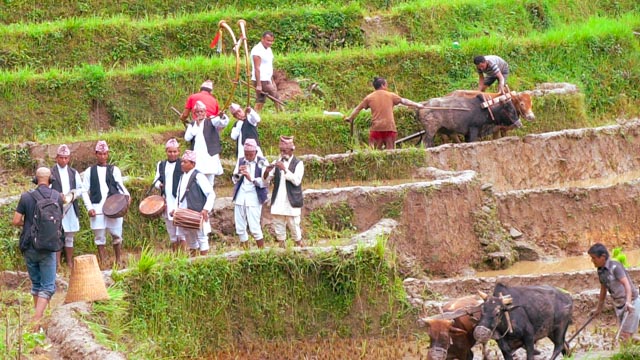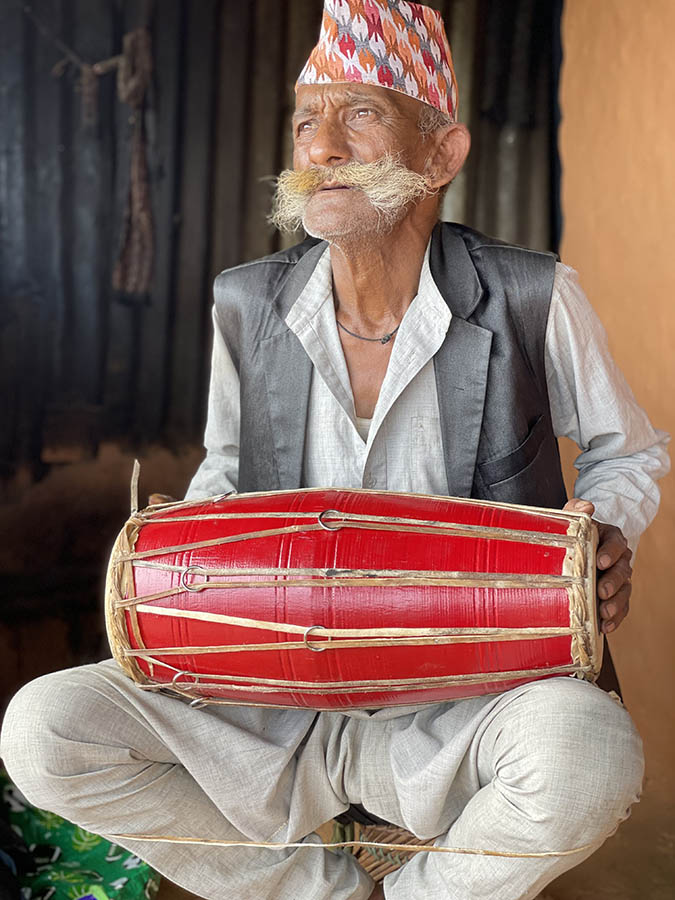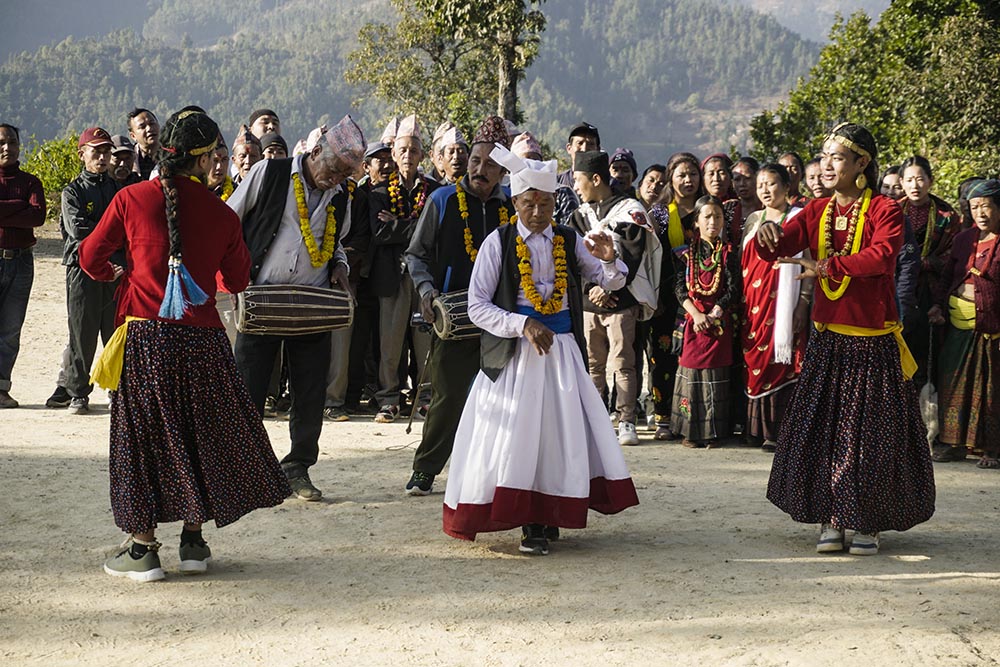Collaboratively Documenting and Revitalizing Traditional Performance in Nepal
The first time I went to Nepal, in the year 2000, I ended up hanging out at a record store. The owner Mangal Maharjan introduced me to a spry man in his seventies who taught music and dance at a local school, rode his bicycle back and forth to work every day, and used the room behind the store for private lessons.
This was Surendra Bikram “Subi” Shah, a nationally honored performer, educator, and retired Army colonel, who had made it his life’s work to develop, sustain, and promote the Nepali folk genres of music, dance, and drama that he had learned as a child and performed all his life. Having grown up in a semi-royal landowning family who were patrons of pangdure dance troupes and themselves performed in these same troupes, Subi was an expert on connections among music, song, dance, drama, ritual life, and the spiritual world. He had strong opinions and a wealth of knowledge about how to preserve and promote the culture he cared about, and was trying to leave a lasting legacy.
Subi Shah’s books describe genres intricately connected with local social life and religious practice in the performance tradition known as pangdure in Nepal’s central hills. As our team works on translating them into English for open access online publication – with accompanying musical transcriptions, audio and video recordings, and annotations – we reflect on their author’s legacy and the potential for our work to spark new interest and innovation in traditional music and dance.
“I have an album to release, but none of the companies want it,” Subi said, a few years later. It was a self-produced cassette of instrumental renderings of folk songs. Recorded in his own home using two cassette recorders, he had played all the parts himself [Fig. 1]. We had an idea: we would minimally edit the cassette recordings and release a demo CD, to help him convince the companies of interest in such recordings. We included his extensive liner notes in Nepali and in English translation, and this became the demo CD Nepali Folk Music: One Man’s Endeavors (EMW 2005). The demo CD worked, and Subi released a similar, professionally recorded album a few more years later: One Man’s Endeavors (Music Nepal 2008).
We then turned to his writings. Subi’s best-known book, Madal, is a treatise on how to play this barrel drum used in many different Nepali performance genres. First published in 1983, it has taught many music students, including me, the basics of madal playing, music theory, and cultural background. “Maybe you could translate this too, along with my other books! I have some that aren’t even published yet!” Subi suggested.
Among his other published books were Glimpses of Nepali Folk Song and a textbook section introducing Nepali folk dances. Unpublished were an in-depth look at these dances with a dance notation of his own invention, Dances of Central Nepal; a book on tunes and his theories of melody, Introduction to Nepali Tunes; and a study of the Sorati dance-drama, including its full oral text, as performed in his home village of Jyamrung in Dhading district.
With detailed information about pangdure genres’ social importance and their connections to numinous beings of the sacred landscape, Subi Shah’s writings are the only scholarship on these genres that analyzes and provides concrete, interrelated examples of all aspects of performance. They are a treasure trove of information for scholars and performers alike.
Before we could start translating together, Subi Shah passed away in 2008. I slowly began to translate Madal. In 2021, I began working with a group of scholars, performers, and community members to translate the books and film performances. We approach our work with Subi’s holistic vision in mind, collaborating online, in Kathmandu, in Subi Shah’s village of Jyamrung, and in nearby Sohraghar in Dhading. Some glimpses from our research and recording process follow.
Songs, tunes, and memories
In Introduction to Nepali Tunes, Shah discusses the ragas played by the Naumati Baja ensemble, linked with rituals performed at different times of the day and night. These we recorded in July 2022, in Subi Shah’s home village in Jyamrung, with the Sankha Devi Jyamrung Darbar Naumati Panchai Baja ensemble, led by Ram Bahadur Sundas [Fig. 2]. Jyamrung’s Pangdure dance troupe used to perform in the same location, once the courtyard of the palace where Subi Shah was born. The troupe and the Jyamrung Darbar palace no longer exist, but the Naumati Baja is one of the most sought-after in the region.
Fig. 2: Recording Naumati Baja ragas
in front of Jyamrung Darbar’s old stables.
There are also seasonal ragas like asare, performed in the monsoon rice-planting season. We decided to film a traditional scene of the Naumati Baja performing while planters work in the rice fields, rarely found today as tractors whose engines drown out instruments have replaced water buffalo in plowing [Fig. 3]. A hillside of rice fields owned by the Shah family, inaccessible to tractors, provided the perfect setting.

Fig. 3: Dr. Lochan Rijal and the Naumati
Baja soundcheck for the recording of
Asare Rag.
The performer Pitambar Sundas (playing sahanai in the asare video), who played all the instruments of the Naumati Baja ensemble and danced pangdure dances in his day, reminisced about folk songs and his time dancing with the Jyamrung troupe [Fig. 4]. He said, “With Subi Shah, it was really… After we performed at the National Dance Center, we visited government ministers’ homes. And we would play deusi, and dance sorathi. When we danced sorathi, he would dance the maruni part too. He danced all the parts. It was so much fun! The songs from long ago are beautiful. The songs from old customs… We shouldn’t forget our customs. I think it is very good that you’re looking for these good things from long ago. I hope these customs continue. Even if we die, the world will be able to hear them. Right? Others will get to hear them. And everyone will remember that these things happened… The world will get to see them! Right?”

Fig. 4: Pitambar Sundas, multi-
instrumentalist and Pangdure
dancer, at his home with a
madal drum.
Pangdure dances and community
The term pangdure is most often used in central Nepal to describe a set of dance forms performed by multiethnic troupes. These include the sorathi and Krishna charitra dance-dramas, three standalone dance forms (jhyaure, khyali, and chudka), more local forms, and all of their music and lyrics. These names also denote rhythmic cycles and poetic meters, and knowing their interconnections helps make sense of folk song and dance categories throughout the Himalayan foothills. Pangdure is also known as maruni, after the name of the female role type. The roles include the pursunge or lead dancer, the madale dancers who dance with madals around their waists, and the female or female-dressed maruni dancers. Originally, all dancers were male; while there are now many female maruni dancers, men dancing the female role type remains common. The troupe we worked with in Sohraghar, Dhading, had all male dancers. They were delighted to have an occasion to perform, and they trained for a month before filming. The gurus welcomed the chance to teach new dancers, and the new dancers welcomed the chance to learn. The maruni dancers in these photos and videos are the newly minted members of this dance troupe.
Pangdure dances are preceded by rituals that sacralize the space and time for dancing, and "bind" the performing troupe together with the blessings of the local deities and the Hindu goddess of music, Saraswati. Troupe members embody these blessings – and, sometimes, the goddess herself – through participating in song and drum sequences that can lead to possession by Saraswati, and eventually through consuming the blessed ritual offerings, prasad.
Possession by Saraswati at such an event is a positive thing, but it still contains an element of danger: if the person possessed is not released skillfully, they may become sick. The invocatory rhythm, called thakan or thokan, creates the sacred space for performance and is also used to release people from possession. The thakan is first played on the madal, followed by a song invoking multiple deities near and far, called garra bandhne, meaning “troupe-binding.” When this song is finished, the thakan is played again, repeated as needed to release people from possession. This all requires considerable skill in drumming.
Calling Saraswati to Dance depicts the ritual sequence as performed in Sohraghar in January 2023 at the home of our team member Rita Thapa Magar, with the support of her entire village. The video shows the multisensory offerings, the songs of worship, and the drum sequences that call Saraswati to the performance space. When Rita’s brother Anand became possessed and the madal strap broke, everyone was tense: could the drummers successfully release him from possession and carry on with the day's performances?
Once Anand was successfully released from possession and the tense moment had passed, we moved to a field for dancing. Figure 5 provides a glimpse of one Krishna charitra song and dance – a vibrant performance with lyrics about the life of the god Krishna.

Fig. 5: Krishna Charitra
song and dance.
We continually ask ourselves: How can our work best be a resource for scholars and communities who want to maintain and innovate on their holistic performance practices? For some of us, these research areas are home. These team members see our work as a potential jumping-off point for a variety of future projects, and as a way to emphasize the performance genres’ value in and beyond their communities.
The community members on our research team emphasize the importance of making performance inclusive and enjoyable. Rita Thapa Magar says, “you have to get the whole village involved,” which indeed she did for our days in Sohraghar, and which she often does for her own folk music videos. Dhruva Shah, the son of Subi Shah, became an Olympic riflery coach rather than a performer, and he remembers his father’s strong opinions: “He kept saying that it had to be done this way, it couldn’t be done that way, and I wanted to do new, modern things when I was young, so I didn’t learn music.” He offers, “If young people see it as ossified or waning, not valued, and therefore not worth continuing, they are less likely to join in.” Ram Bahadur Sundas hopes to find more recordings of his family members in national and private archives, make them available to the ensemble to remember their forebears, and keep learning from them.
What started with Subi Shah’s desire to preserve his traditions, and my desire to share his works with a broader audience, has gained multiple meanings to different participants, and the end goal of producing a multimedia publication keeps us working together to support these varied performance traditions in multiple ways. We look forward to seeing what the future holds.
List of resources
Note: Music and Dances of Central Nepal: Subi Shah’s Works on Pangdure (Maruni) Performance is scheduled to be published with Open Book Publishers in fall 2024.
Video: Asare Ropai
Video: Pitambar Sundas Sorathi Songs
Caption: Pitambar Sundas sings songs from the Sorathi dance-drama, reminisces, and approves of our project.
Video: Calling Saraswati to Dance
Video: Krishna Charitra
Team
Project Director Dr. Anna Stirr; Co-Project Director Dr. Mason Brown (musical transcriptions lead); Hikmat Khadka (2nd translator); Dr. Lochan Rijal, (audiovisual production lead; 3rd translator); community liaisons Rita Thapa Magar and Dhruva Shah (Subi Shah’s son); production assistants Rajan Shrestha, Dinesh Raj Upadhyaya, and Pranim Thapa; Jyamrung performers Ram Bahadur Sundas, Pitambar Sundas and the Sankha Devi Jyamrung Darbar Naumati Panchai Baja; Sohraghar’s Jalkanya Devi Yuva Club, and many more. This project is supported by a Scholarly Editions and Translations grant from the US National Endowment for the Humanities.
Anna Stirr is Associate Professor of Asian Studies at the University of Hawaii at Manoa. Email: stirr@hawaii.edu